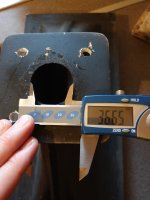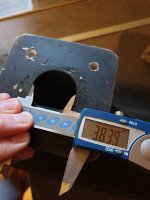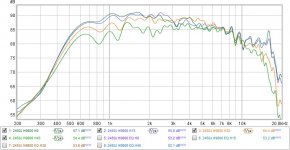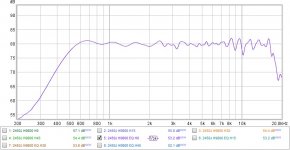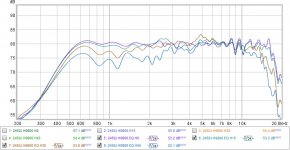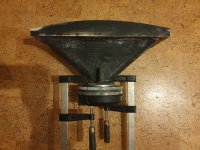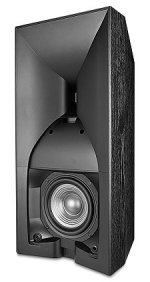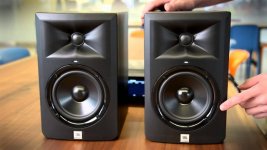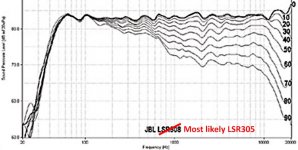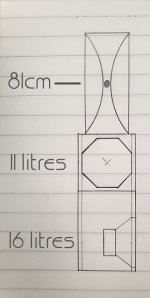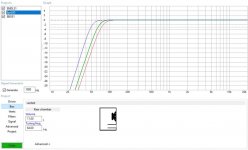Graham,
Look at all the links that Rob has provided.
You'll see almost identical Zig-Zags ( as yours ) on JBL's official cut sheets for the 2450 ( especially from 8K upwards ).
It appears ( from what you said ) that the entry diameter of your H9800's is closer to 1.4" ( 35.6 mm ), if so I would keep it at that diameter since that size offers greater flexibility when choosing a different driver.
As I said ( or implied ) earlier , twin 8's will sound more musically balanced if you use a compression driver that has a diaphragm 44mm or smaller.
- Eminence makes a great ( short flare ) 1" to 1.4" adapter for this sort of lash-up .
This is the driver I would recommend ( to use with twin 8's ) .
Peerless 35mm diaphragm driver
- Unfortunately, it look's like neither of the above is available on your side of the Atlantic from the usual suspects ( Thomann, Blue Aran, Lean Business ).
🙂
Look at all the links that Rob has provided.
You'll see almost identical Zig-Zags ( as yours ) on JBL's official cut sheets for the 2450 ( especially from 8K upwards ).
It appears ( from what you said ) that the entry diameter of your H9800's is closer to 1.4" ( 35.6 mm ), if so I would keep it at that diameter since that size offers greater flexibility when choosing a different driver.
As I said ( or implied ) earlier , twin 8's will sound more musically balanced if you use a compression driver that has a diaphragm 44mm or smaller.
- Eminence makes a great ( short flare ) 1" to 1.4" adapter for this sort of lash-up .
This is the driver I would recommend ( to use with twin 8's ) .
Peerless 35mm diaphragm driver
- Unfortunately, it look's like neither of the above is available on your side of the Atlantic from the usual suspects ( Thomann, Blue Aran, Lean Business ).
🙂
I would NOT equalise it to dead flat. It will sound harsh that way (for a multitude of reasons that I have no time to explain here).
Aim for a gently sloping FR from ~1kHz up.
Also, no matter what you do, >10kHz from the stock ribbed Ti dia is NOT going to sound refined and "high end"...
Hi Marco,
Thanks very much for your input here. I looked up the 4635 crossover that uses the 2450 and it use it from 750 upwards, when I said 1000hzish i meant, very broadly, around this area. so nearer to 750 would be the goal.
I also mentioned that using it to 18k would only be until I found a UHF driver so I recognise the breakup is not ideal.
Do you have any thoughts regarding the throat aperture mating?
Thanks, Rob, for the information, very useful.
That Peerless drive is available in Europe from Moteur de compression Peerless DFM-2535R00-08, 8 ohm, sortie 1 pouce and equivalent 1-1.4 adapters are available.
Just to clarify, you also think the 2450J is a poor choice both with this horn and with my proposed woofer set up? I'm genuinely interested in your thoughts 🙂
The actual aperture dimensions come in at: 38.4 x 36.7 mm.
Graham,
Look at all the links that Rob has provided.
You'll see almost identical Zig-Zags ( as yours ) on JBL's official cut sheets for the 2450 ( especially from 8K upwards ).
It appears ( from what you said ) that the entry diameter of your H9800's is closer to 1.4" ( 35.6 mm ), if so I would keep it at that diameter since that size offers greater flexibility when choosing a different driver.
As I said ( or implied ) earlier , twin 8's will sound more musically balanced if you use a compression driver that has a diaphragm 44mm or smaller.
- Eminence makes a great ( short flare ) 1" to 1.4" adapter for this sort of lash-up .
This is the driver I would recommend ( to use with twin 8's ) .
Peerless 35mm diaphragm driver
- Unfortunately, it look's like neither of the above is available on your side of the Atlantic from the usual suspects ( Thomann, Blue Aran, Lean Business ).
🙂
That Peerless drive is available in Europe from Moteur de compression Peerless DFM-2535R00-08, 8 ohm, sortie 1 pouce and equivalent 1-1.4 adapters are available.
Just to clarify, you also think the 2450J is a poor choice both with this horn and with my proposed woofer set up? I'm genuinely interested in your thoughts 🙂
The actual aperture dimensions come in at: 38.4 x 36.7 mm.
Attachments
More Experiments:
2450J Snout Removed and mated to H9800 horn @ 1 metre (wife was working so I couldn't do 1watt) Gated at 4ms.
Clamped to horn.
Flatness is merely to provide information about off axis response.
Raw 0 Degrees

Raw 0-15-30-45 Degrees

EQ'd Flat 0 Degrees

EQ'd Flat 0-15-30-45 Degrees

2450J Snout Removed and mated to H9800 horn @ 1 metre (wife was working so I couldn't do 1watt) Gated at 4ms.
Clamped to horn.
Flatness is merely to provide information about off axis response.
Raw 0 Degrees
Raw 0-15-30-45 Degrees
EQ'd Flat 0 Degrees
EQ'd Flat 0-15-30-45 Degrees
Attachments
Last edited:
That Peerless drive is available,Moteur de compression Peerless DFM-2535R00-08, 8 ohm, sortie 1 pouce
Thanks for that link, that's very handy to know for future conversations.
Just to clarify, you also think the 2450J is a poor choice both with this horn and with my proposed woofer set up?
I'm sure that the driver/horn combo can be made to sound great ( & certainly with a different diaphragm substituted + then mated to larger woofers ) .
Since you already have this combo in hand, use it, optimize it's response and then live with it for a while ( > at least 6 months ).
If you find ( after EQ + level optimization ) that music playback is a bit mid heavy then try a smaller diaphragmed driver ( 25mm to 44mm ), something with perhaps a mylar diaphragm.
- Compression driver exit size has little ( to nothing ) to do with what I'm getting at ( balancing diaphragm sizes across a multiway system ).
Moving to a smaller diameter HF diaphragm will simply be replicating JBL's own approach where they use a small diameter compression driver mated to a large vertical horn ( as found in their Studio 500 Series of boxes ) .
The actual aperture dimensions come in at: 38.4 x 36.7 mm.
Oh, OK. Seems like a 35.6mm ( 1.4" ) adapter could be a challenge to make work ( ie; smooth out the transitions ) .
🙂
Attachments
Thanks so much for posting those.
Your measurement seems similarly confused ( in it's polar response > which was Horizontal I presume ?? ) to this ( Horizontal ) measurement made by POS ( of a H9800 driven by JBL 435Be driver) .
Orienting your horn vertically ( and then measuring horizontally for new polars ) should mimic the following response ( also from POS );

Polars ( as seen immediately above with such nicely delineated//separated polar traces ) will offer very good speaker imaging and that should go a long way to making your project worthwhile .
🙂
Last edited:
Wow, thanks Earl! I would never have bothered to check that had I not known. I wonder what the driver that is meant to be with the H9800 looks like in its horizontal off axis response?
I take your points on board, Earl, I'm sifting around making lots of compromises to use this combo and at the end of the day there is still an issue with the horn in the 8k-10k region that looks a lot like baffle diffraction so I know its a physical issue that needs to be sorted out. I'm convinced its that 1mm over hand on the throat entry on each side...
Lots of thinking to be done!
I take your points on board, Earl, I'm sifting around making lots of compromises to use this combo and at the end of the day there is still an issue with the horn in the 8k-10k region that looks a lot like baffle diffraction so I know its a physical issue that needs to be sorted out. I'm convinced its that 1mm over hand on the throat entry on each side...
Lots of thinking to be done!
Hi all!
As I said I would lots of thinking has been done. I got rid of the 2450J drivers as I was beginning to make too many compromises and they are drivers for a master system - one which am I not ready to design and build from scratch.... yet.
Sooooo.....
I took Earls advice and got hold of some 1"-1.5" adapters and ran an experiment. Previously I have horn loaded the SB Acoustics SB19ST-C000-4 19mm tweeter on a Faital Pro STH100 horn and had good results. This is following PatrickBateman and his many experiments. The dip mid teens is due to the path length and reflections inside the throat, I am led to understand:

So, I thought, why can't I do this with the H9800s to make sure they provide the imaging I want before I stump up for comp drivers?





I got some very good results, I think. The dip has been pushed up a touch and is completely gone at 15 degrees.




I think what this points to is trying out the Peerless DFM-2535R00-08 which has a low FS of 745hz so I can cross around 900hz if I use a very steep filter. I'm a happy one today!
Thanks for the ongoing input from everyone!
As I said I would lots of thinking has been done. I got rid of the 2450J drivers as I was beginning to make too many compromises and they are drivers for a master system - one which am I not ready to design and build from scratch.... yet.
Sooooo.....
I took Earls advice and got hold of some 1"-1.5" adapters and ran an experiment. Previously I have horn loaded the SB Acoustics SB19ST-C000-4 19mm tweeter on a Faital Pro STH100 horn and had good results. This is following PatrickBateman and his many experiments. The dip mid teens is due to the path length and reflections inside the throat, I am led to understand:
So, I thought, why can't I do this with the H9800s to make sure they provide the imaging I want before I stump up for comp drivers?
I got some very good results, I think. The dip has been pushed up a touch and is completely gone at 15 degrees.
I think what this points to is trying out the Peerless DFM-2535R00-08 which has a low FS of 745hz so I can cross around 900hz if I use a very steep filter. I'm a happy one today!
Thanks for the ongoing input from everyone!
Attachments
-
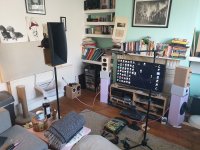 20200118_111159.jpg325.9 KB · Views: 613
20200118_111159.jpg325.9 KB · Views: 613 -
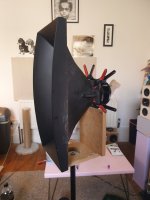 20200118_105538.jpg181.9 KB · Views: 682
20200118_105538.jpg181.9 KB · Views: 682 -
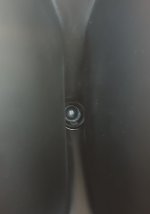 20200118_100718.jpg56.5 KB · Views: 534
20200118_100718.jpg56.5 KB · Views: 534 -
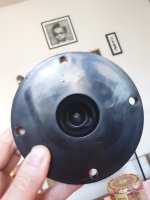 20200118_100142.jpg142 KB · Views: 543
20200118_100142.jpg142 KB · Views: 543 -
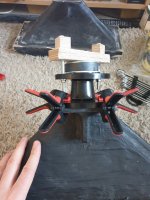 20200118_100752.jpg266.2 KB · Views: 550
20200118_100752.jpg266.2 KB · Views: 550 -
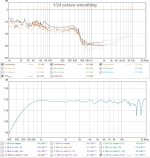 H9800 SB19 DST.jpg150.9 KB · Views: 571
H9800 SB19 DST.jpg150.9 KB · Views: 571 -
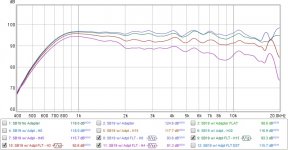 H9800 SB19 0-45.jpg91 KB · Views: 536
H9800 SB19 0-45.jpg91 KB · Views: 536 -
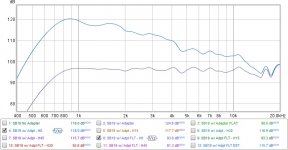 H9800 SB19 RAW to FLAT.jpg82.1 KB · Views: 553
H9800 SB19 RAW to FLAT.jpg82.1 KB · Views: 553 -
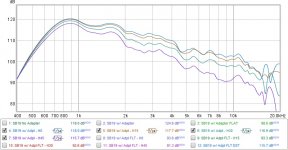 H9800 SB19 RAW 0-45.jpg94.6 KB · Views: 568
H9800 SB19 RAW 0-45.jpg94.6 KB · Views: 568 -
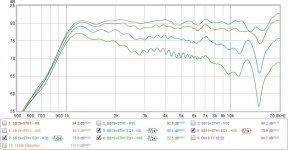 EQ'd Flat 0-15-30-45.jpg94.1 KB · Views: 542
EQ'd Flat 0-15-30-45.jpg94.1 KB · Views: 542
Graham,
Nice! Real Nice!
Love the creativity.
Those are some wonderful results you're getting.
Yep, and it's a good thing to channel all of Patrick Bateman's work 😉
I'm glad to see you using all the resources on hand .
🙂
Nice! Real Nice!
Love the creativity.
Those are some wonderful results you're getting.
Yep, and it's a good thing to channel all of Patrick Bateman's work 😉
I'm glad to see you using all the resources on hand .
🙂
Last edited:
Thanks for the feedback guys. I'm starting to feel really positive about this again!
As soon as my wife and I buy a house I'm thinking CNC and 3D printer but we'll not bring that up with her yet.
Nice results!
Soon you're going to find yourself lusting after 3D printers...
As soon as my wife and I buy a house I'm thinking CNC and 3D printer but we'll not bring that up with her yet.
OK, so I have some thoughts/questions if anyone fancies giving there tuppence worth...
Having gone back over this thread a few times it was mentioned that JBL used specially designed woofers for directivity matching. I asked a little question on an FB group about how, if at all, is it possible to control directivity in this respect.
The answer was basically, no, unless it is horn loaded. Which made me think about the JBL Studio 530 of which I lusted after a couple of years ago. How do they get this woofer and horn combo to be cohesive? I think it must lie partly in the wave guide/horn profile that surrounds the woofer. I can't find any measurements of it, though.

This is also achieved somewhat with the LSR305 budget studio monitor which has a crossover point of 1725hz and looks like this:


(Source: JBL LSR305 & LSR308 measurements)
Although the off axis response is not perfect and becomes dog-legged at 600hz it is still not a bad looking response. How are they achieving this and how can I achieve it with an 8"?
Having gone back over this thread a few times it was mentioned that JBL used specially designed woofers for directivity matching. I asked a little question on an FB group about how, if at all, is it possible to control directivity in this respect.
The answer was basically, no, unless it is horn loaded. Which made me think about the JBL Studio 530 of which I lusted after a couple of years ago. How do they get this woofer and horn combo to be cohesive? I think it must lie partly in the wave guide/horn profile that surrounds the woofer. I can't find any measurements of it, though.
This is also achieved somewhat with the LSR305 budget studio monitor which has a crossover point of 1725hz and looks like this:
(Source: JBL LSR305 & LSR308 measurements)
Although the off axis response is not perfect and becomes dog-legged at 600hz it is still not a bad looking response. How are they achieving this and how can I achieve it with an 8"?
Attachments
Secondly, I am starting to home in on the mid-woofer I am after. To begin with I can only afford one per side and my system will be comprised of modular stacked cabinets like this:

(Height will probably be a bit higher after cabinet feet, isolation, etc).
Top is the horn/CD combo.
Middle is mid bass (11 litre cabinet)
Bottom is the sealed subwoofer (16 litre cabinet)
Options for driver so far have yielded these contenders to be crossed over to the sub at 100hz:
B&C 8NDL51 (B&C Speakers) - Red curve - 10 litre bass reflex
Faital Pro 8PR200 (FaitalPRO | LF Loudspeakers | 8PR200) - Green curve - 11 litre cabinet
B&C 8BG51 (B&C Speakers) - Blue curve - 16 litre cabinet

The 8BG51 looks good but the box will be too big and it shows a jagged response after 1k which might prove problematic. The 8NDL51 has the right sized box but less low response and has the same jagged response after 1k. The 8PR200 goes lower in the right sized box and has a much cleaner response going up to 3k.
So far my feelings are with the initial plan for the 8PR200 but I am entirely open to changing this. Thoughts anyone?
Super sorry for all the words but no apologies for the pencil drawing when I should be learning CAD.
(Height will probably be a bit higher after cabinet feet, isolation, etc).
Top is the horn/CD combo.
Middle is mid bass (11 litre cabinet)
Bottom is the sealed subwoofer (16 litre cabinet)
Options for driver so far have yielded these contenders to be crossed over to the sub at 100hz:
B&C 8NDL51 (B&C Speakers) - Red curve - 10 litre bass reflex
Faital Pro 8PR200 (FaitalPRO | LF Loudspeakers | 8PR200) - Green curve - 11 litre cabinet
B&C 8BG51 (B&C Speakers) - Blue curve - 16 litre cabinet
The 8BG51 looks good but the box will be too big and it shows a jagged response after 1k which might prove problematic. The 8NDL51 has the right sized box but less low response and has the same jagged response after 1k. The 8PR200 goes lower in the right sized box and has a much cleaner response going up to 3k.
So far my feelings are with the initial plan for the 8PR200 but I am entirely open to changing this. Thoughts anyone?
Super sorry for all the words but no apologies for the pencil drawing when I should be learning CAD.
Attachments
Last edited:
Hi Graham,
Since you already have a woofer to use below your ( prospective ) midbass, I would choose ( whichever ) has the nicest response over 1K.
In the long-run that'll be more versatile to own ( not just for this project ).
🙂
Since you already have a woofer to use below your ( prospective ) midbass, I would choose ( whichever ) has the nicest response over 1K.
In the long-run that'll be more versatile to own ( not just for this project ).
🙂
The answer was basically, no, unless it is horn loaded. Which made me think about the JBL Studio 530 of which I lusted after a couple of years ago. How do they get this woofer and horn combo to be cohesive? I think it must lie partly in the wave guide/horn profile that surrounds the woofer. I can't find any measurements of it, though.
Hello Graham
All dynamic drivers have narrowing directivity as you go up in frequency. What they do is pick a crossover frequency so the horn and driver have the same directivity at the crossover point. JBL uses CD horns so the horn maintains basically the same directivity after the crossover point. You can do this with any size driver.
Read this explains it better than me.
Improvements in Monitor Loudspeaker Systems
Rob 🙂
Last edited:
Thanks Earl & Rob.
Interesting reading on that paper. Especially the "waist banding" that I am still trying to full comprehend.
Patrick Bateman made a post elsewhere regarding restricting apertures on woofers to reduce directivity on JBL units. If I have issues with matching the horn to the woofer this might be an avenue to explore.
On another note, I am going to be making an order late this week for the CDs and woofers (yay).
Does anyone know the depth of the M6 bolt holes so that I can order ahead of the time the appropriate hardware, please?
Interesting reading on that paper. Especially the "waist banding" that I am still trying to full comprehend.
Patrick Bateman made a post elsewhere regarding restricting apertures on woofers to reduce directivity on JBL units. If I have issues with matching the horn to the woofer this might be an avenue to explore.
On another note, I am going to be making an order late this week for the CDs and woofers (yay).
Does anyone know the depth of the M6 bolt holes so that I can order ahead of the time the appropriate hardware, please?
The depth of the threads ( on the Peerless Tymphany driver are @ 5mm ( which is the full thickness of the frontal plate that's glued to the ferrite magnet ).
I use M6 studs ( that typically ship with one of the many B&C or Celestion drivers that I also own ).
They look very much like this;
M6 Stud mounting pack

( I think that's what you should use if the long end works with the flange of that horn/throat adapter )
🙂
I use M6 studs ( that typically ship with one of the many B&C or Celestion drivers that I also own ).
They look very much like this;
M6 Stud mounting pack

( I think that's what you should use if the long end works with the flange of that horn/throat adapter )
🙂
Battle of the Horns - H9800 vs. STH100
Data!
The CD's and woofers arrived so here is some data on the Peerless DFM-2535R00-08 on the two horns I have. JBL H9800 molded clone and Faital Pro STH100.
All taken at 75cm, gated at 3.8ms and smoothed at 1/24th.

H9800 + DFM-2535R00-08




STH100+ DFM-2535R00-08




As always all observations and feedback is welcome! 🙂
Data!
The CD's and woofers arrived so here is some data on the Peerless DFM-2535R00-08 on the two horns I have. JBL H9800 molded clone and Faital Pro STH100.
All taken at 75cm, gated at 3.8ms and smoothed at 1/24th.
H9800 + DFM-2535R00-08
STH100+ DFM-2535R00-08
As always all observations and feedback is welcome! 🙂
Attachments
-
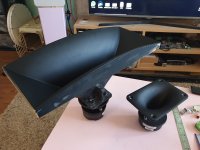 20200206_091456.jpg204.5 KB · Views: 615
20200206_091456.jpg204.5 KB · Views: 615 -
 RAW H9800 DFM 0-15-30-45.jpg94.4 KB · Views: 557
RAW H9800 DFM 0-15-30-45.jpg94.4 KB · Views: 557 -
 RAW + EQ'd Flat H9800 DFM.jpg76.3 KB · Views: 543
RAW + EQ'd Flat H9800 DFM.jpg76.3 KB · Views: 543 -
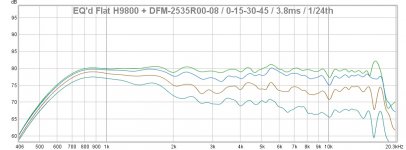 EQ'd Flat H9800 DFM 0-15-30-45.jpg92.5 KB · Views: 560
EQ'd Flat H9800 DFM 0-15-30-45.jpg92.5 KB · Views: 560 -
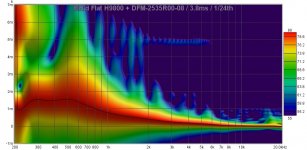 EQ'd Flat H9800 DFM Specto.jpg123.2 KB · Views: 551
EQ'd Flat H9800 DFM Specto.jpg123.2 KB · Views: 551 -
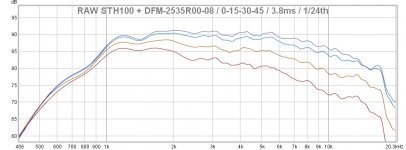 RAW STH100 DFM 0-15-30-45.jpg88.2 KB · Views: 669
RAW STH100 DFM 0-15-30-45.jpg88.2 KB · Views: 669 -
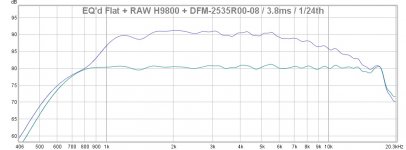 RAW + EQ'd Flat STH100 DFM.jpg73.4 KB · Views: 544
RAW + EQ'd Flat STH100 DFM.jpg73.4 KB · Views: 544 -
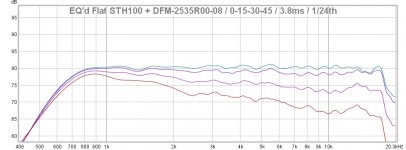 EQ'd Flat STH100 DFM 0-15-30-45.jpg88.8 KB · Views: 596
EQ'd Flat STH100 DFM 0-15-30-45.jpg88.8 KB · Views: 596 -
 EQ'd Flat STH100 DFM Specto.jpg120 KB · Views: 549
EQ'd Flat STH100 DFM Specto.jpg120 KB · Views: 549
- Home
- Loudspeakers
- Multi-Way
- System Based Around JBL H9800 Horn
